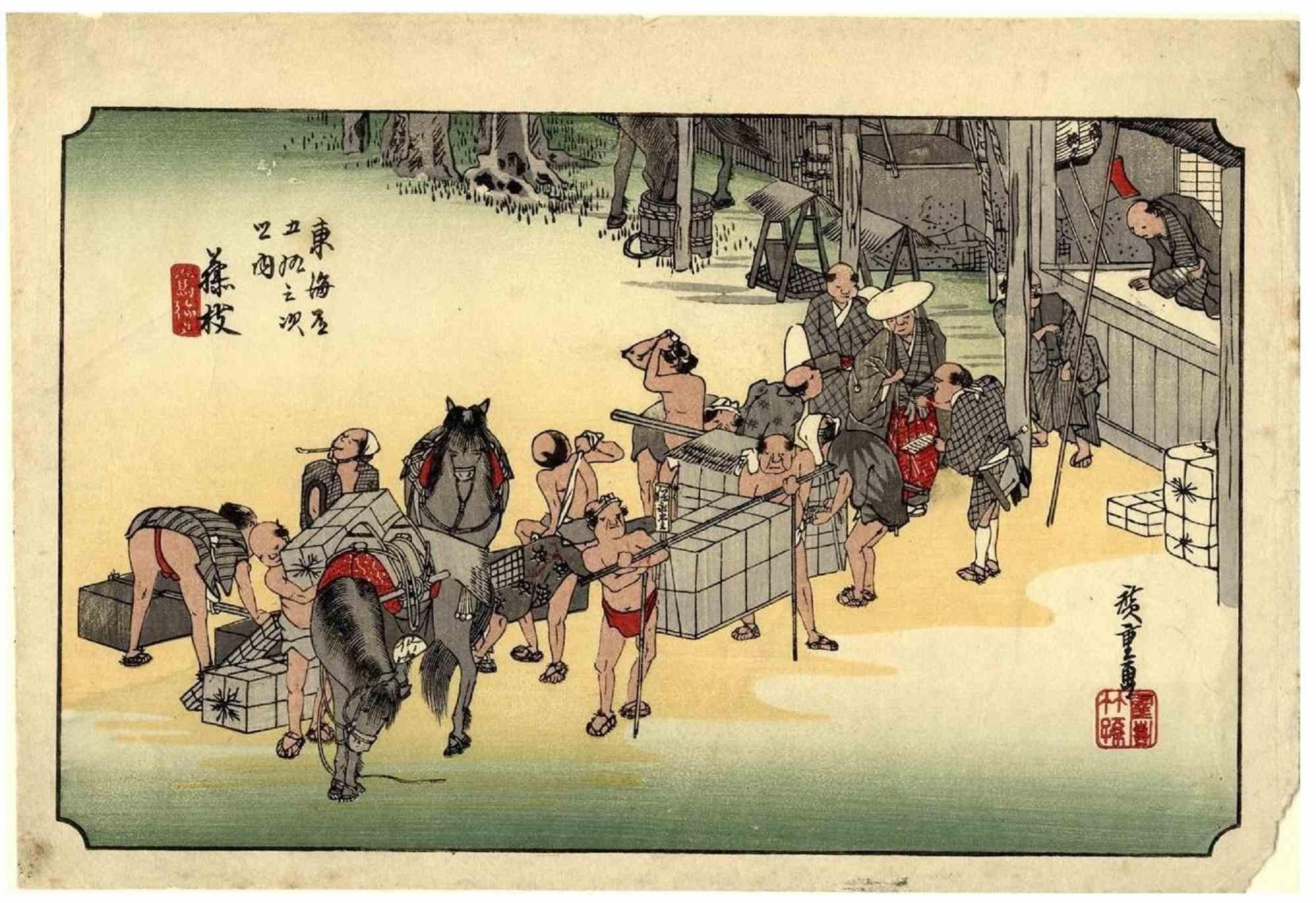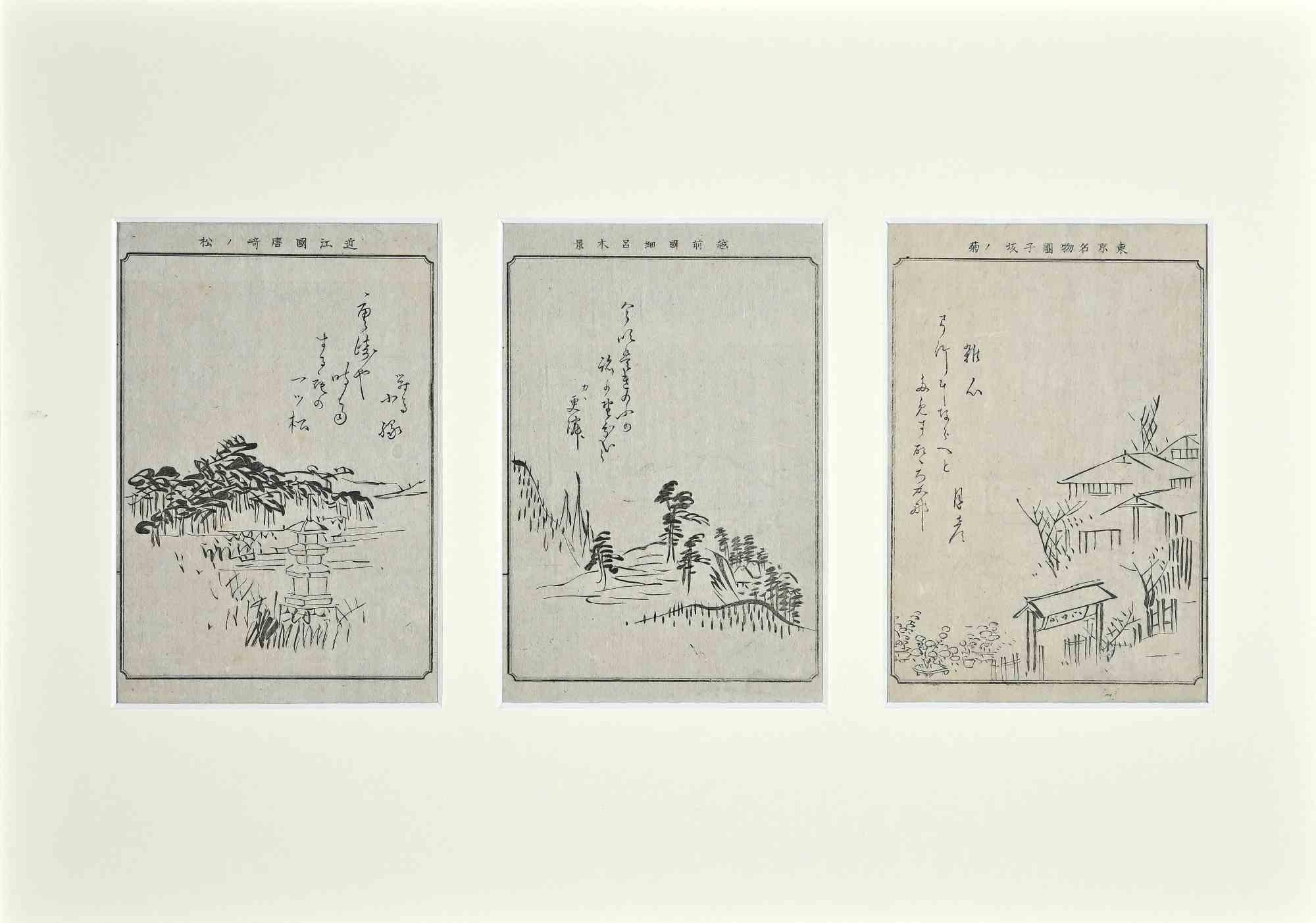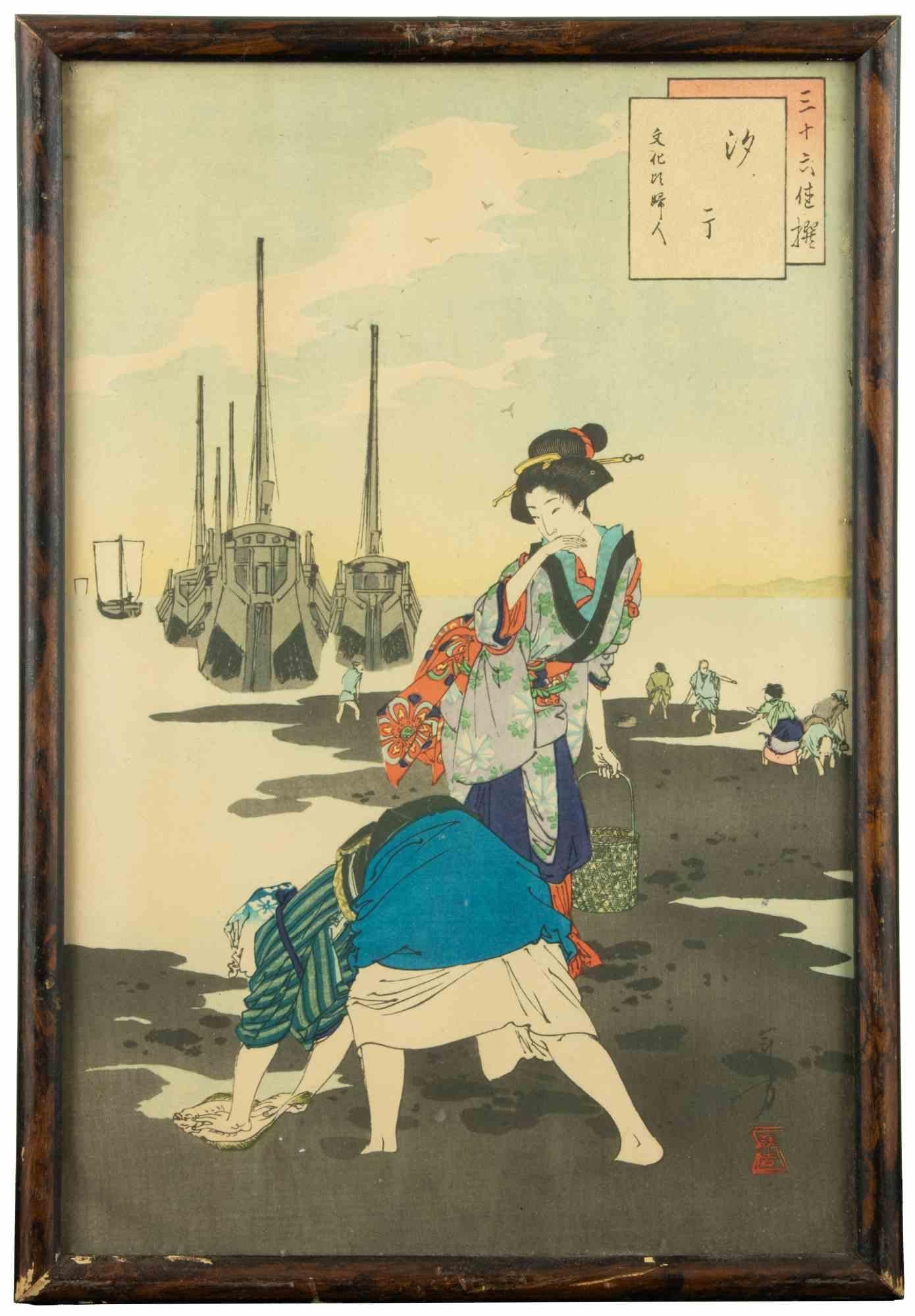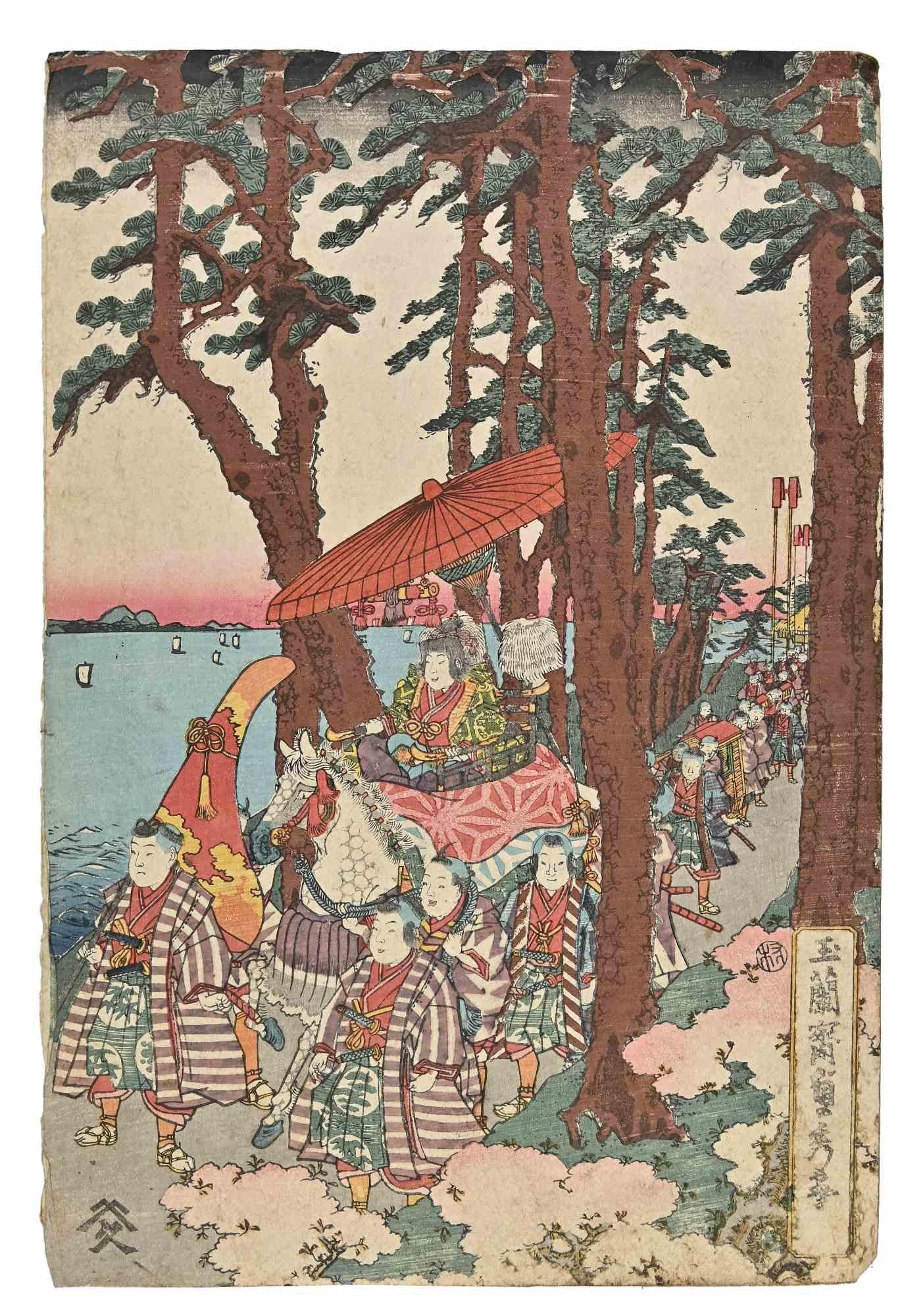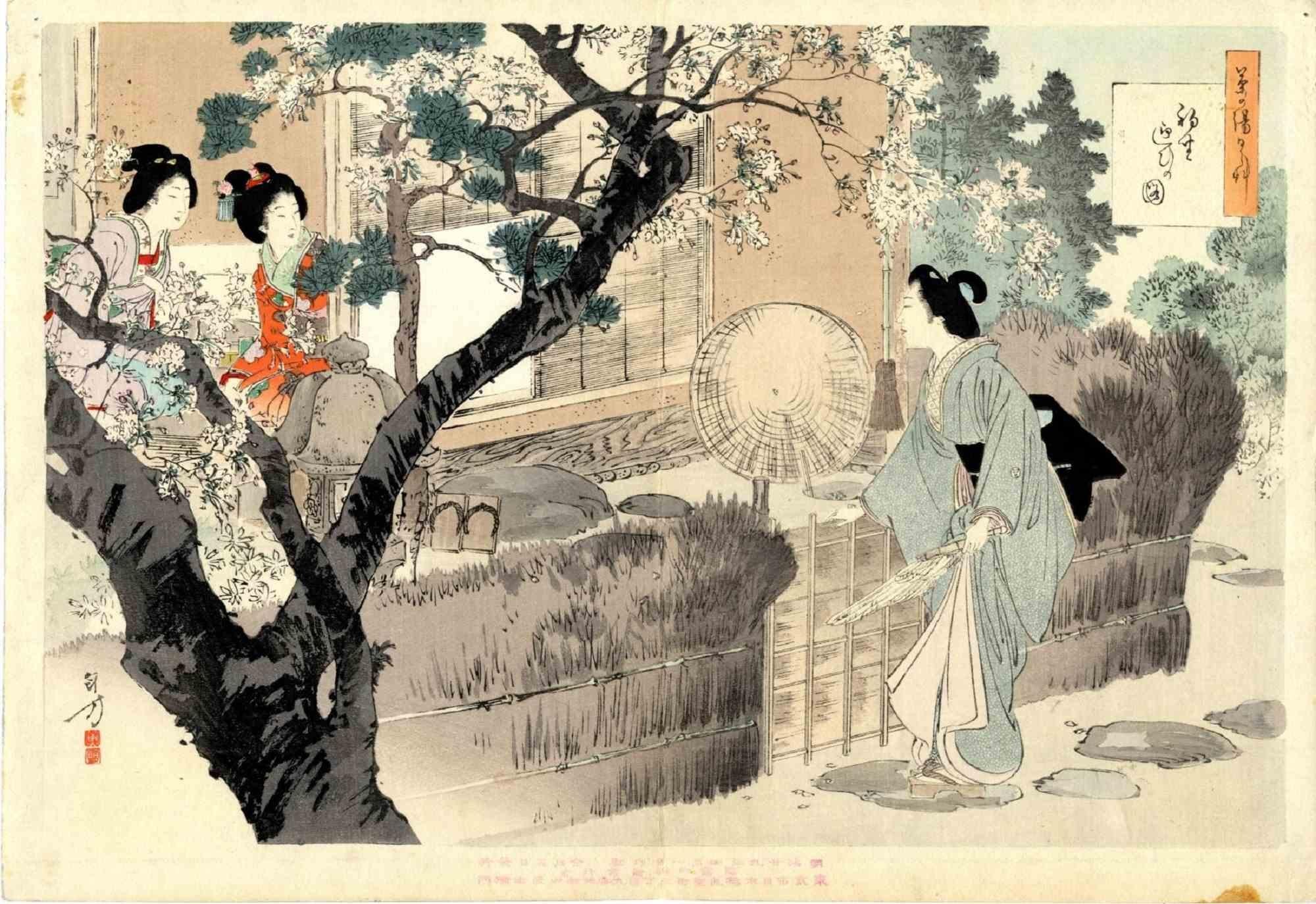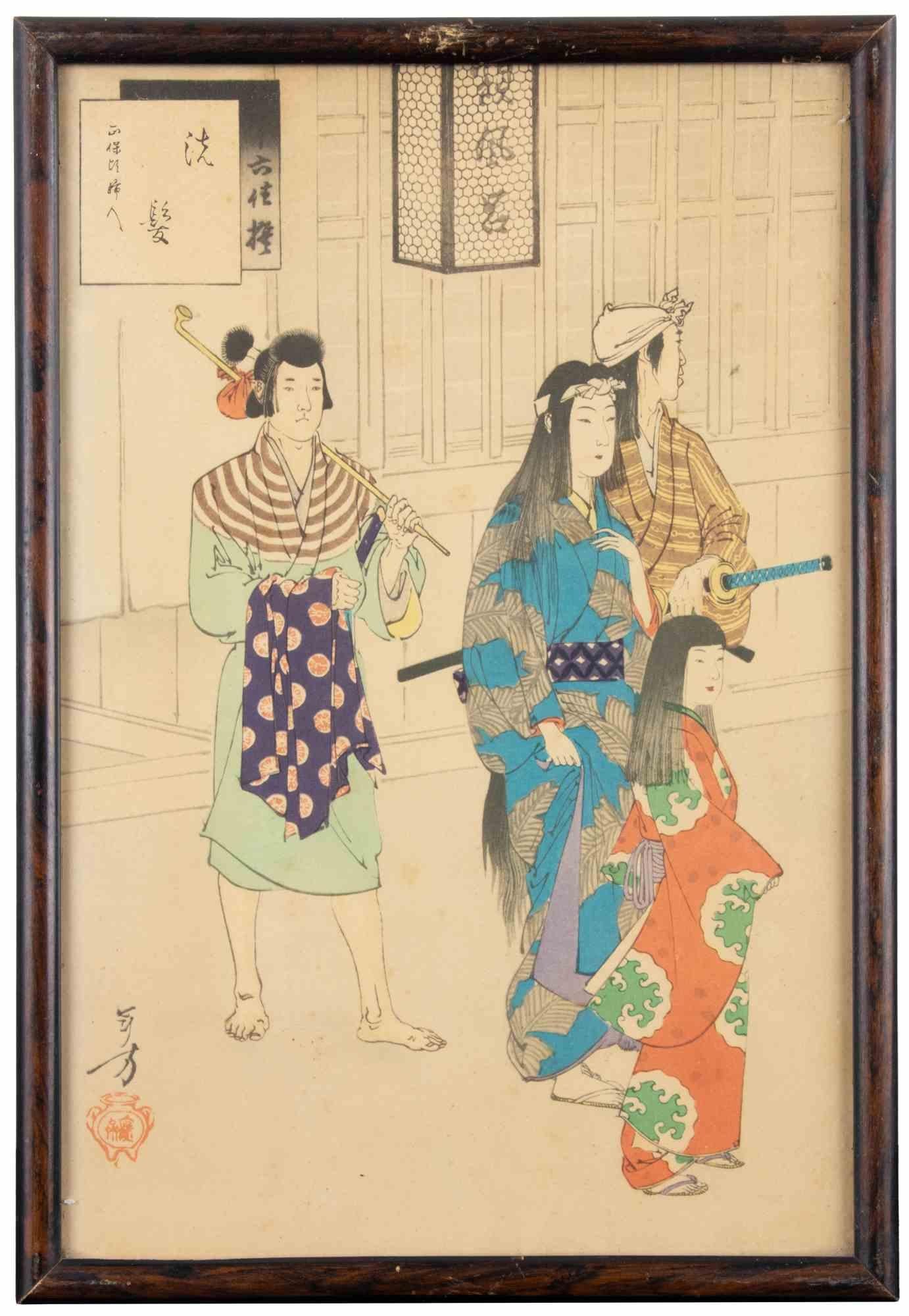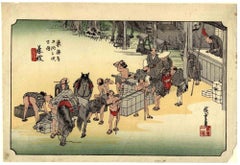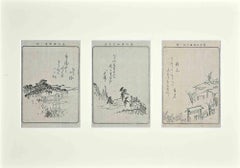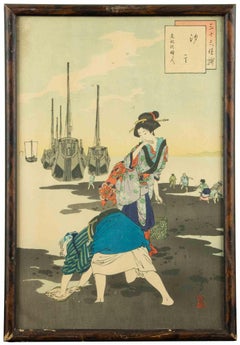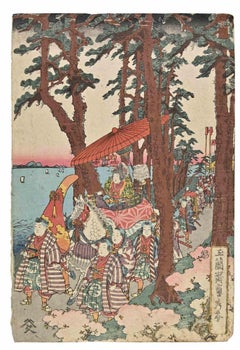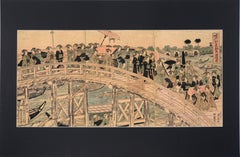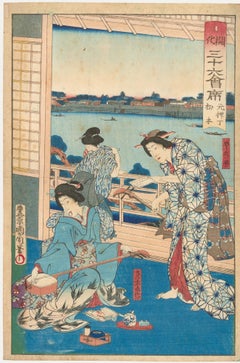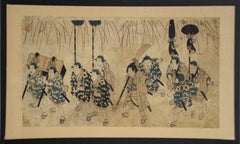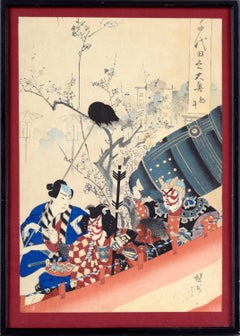Items Similar to The Opening of the Temporary Diet - Woodcut by Ginko Adachi- 1890s
Want more images or videos?
Request additional images or videos from the seller
1 of 2
Ginko AdachiThe Opening of the Temporary Diet - Woodcut by Ginko Adachi- 1890s1890s
1890s
$658.19
£488.92
€550
CA$908.01
A$998.16
CHF 524.59
MX$12,121.27
NOK 6,544.08
SEK 6,200.05
DKK 4,186.88
About the Item
Picture of the opening of the temporary Diet building is an original artwork realized in the 1890s by Ginko Adachi (born 1853; active c. 1870 – 1908).
Sheet dimensions: 22 x 48 cm.
Woodblock print Tryptich.
Original Title "Kokkai kari gijido shinkei" (Picture of the opening of the temporary Diet building). Parade on a bright spring day. The carriage of the emperor and his guard approaches the new building.
Signed: Ginko utsusu. Publisher: Fukuda Kumajiro.
Good lifetime impression, backed, rubbed, painting in black under the wheels of the carriage, lower margin cut, discoloration (aniline red), slightly soiled, one corner torn off, more painting on left sheet.
Adachi Ginko (born 1853; active c. 1870 – 1908) was a Japanese artist best known for his prints in the ukiyo-e style as a member of the Utagawa school. He worked in a variety of genres, including portraits of beauties and actors, landscapes, book illustrations, and satirical works, and produced a large number of triptychs of contemporary events. His most successful work was his Pictorial Outline of Japanese History series of triptychs in the late 1880s. He was jailed and fined in 1889 for caricaturing the Meiji Emperor.
- Creator:Ginko Adachi
- Creation Year:1890s
- Dimensions:Height: 8.67 in (22 cm)Width: 18.9 in (48 cm)Depth: 0.04 in (1 mm)
- Medium:
- Movement & Style:
- Period:
- Condition:Insurance may be requested by customers as additional service, contact us for more information.
- Gallery Location:Roma, IT
- Reference Number:Seller: T-1286651stDibs: LU65039380662
About the Seller
4.9
Platinum Seller
Premium sellers with a 4.7+ rating and 24-hour response times
1stDibs seller since 2017
7,707 sales on 1stDibs
Typical response time: 2 hours
- ShippingRetrieving quote...Shipping from: Monaco, Monaco
- Return Policy
Authenticity Guarantee
In the unlikely event there’s an issue with an item’s authenticity, contact us within 1 year for a full refund. DetailsMoney-Back Guarantee
If your item is not as described, is damaged in transit, or does not arrive, contact us within 7 days for a full refund. Details24-Hour Cancellation
You have a 24-hour grace period in which to reconsider your purchase, with no questions asked.Vetted Professional Sellers
Our world-class sellers must adhere to strict standards for service and quality, maintaining the integrity of our listings.Price-Match Guarantee
If you find that a seller listed the same item for a lower price elsewhere, we’ll match it.Trusted Global Delivery
Our best-in-class carrier network provides specialized shipping options worldwide, including custom delivery.More From This Seller
View AllSeki Station - Woodcut after Utagawa Hiroshige - 1890s
By Utagawa Hiroshige
Located in Roma, IT
Seki Station is an original modern artwork realized after Utagawa Hiroshige in the Late 19th Century.
Original Woodcut print From the Famous "Tokaido Se...
Category
1890s Modern Figurative Prints
Materials
Woodcut
Shiga City - Original Woodcut Print - Early 20th Century
Located in Roma, IT
Shiga City is an original artwork realized by Unknown Artist, in the early 20th Century.
Beautiful woodcut print on cardboard.
This artwork represents three different representatio...
Category
Early 20th Century Modern Figurative Prints
Materials
Paper, Woodcut
Sanjûroku Kasen... - Woodcut by Mizuno Toshikata - 1893
By Mizuno Toshikata
Located in Roma, IT
Nishiki-e (woodcut print), in vertical oban format (31x20.5) realized by Mizuno Toshikata in 1893 (Meiji 26).
Belongs to the Series "Sanjûroku Kasen" (Thirty-Six Beauties in Compari...
Category
1890s Modern Figurative Prints
Materials
Woodcut
Parade - Woodblock Print by Utagawa Kunisada - Mid-19th Century
By Utagawa Kunisada (Toyokuni III)
Located in Roma, IT
Celebratory Parade is an original Woodcut print realized in mid 19th century after Utagawa Kunisada.
Good condition and Beautiful colored woodblock print.
This wonderful modern a...
Category
Mid-19th Century Modern Figurative Prints
Materials
Woodcut
The Art of Tea Ceremony for a Day - Woodcut by Mizuno Toshikata - 1890s
By Mizuno Toshikata
Located in Roma, IT
Bijinga, The art of tea ceremony for a day is an original artwork realized in 1896 by Mizuno Toshikata (1866 - 1908).
Oban yokoe From the series "Chanoyu nichinichi gusa" (The art ...
Category
1890s Modern Figurative Prints
Materials
Woodcut
Sanjûroku Kasen... - Woodcut by Mizuno Toshikata - 1893
By Mizuno Toshikata
Located in Roma, IT
Nishiki-e (woodcut print), in vertical oban format (31x20.5) realized by Mizuno Toshikata in 1893 (Meiji 26).
Belongs to the Series "Sanjûroku Kasen" (Thirty-Six Beauties in Compari...
Category
1890s Modern Figurative Prints
Materials
Woodcut
You May Also Like
Mitate of a Daimyo's Procession Crossing Ryogoku Bridge - Woodblock Print
By Keisai Eisen
Located in Soquel, CA
Mitate of a Daimyo's Procession Crossing Ryogoku Bridge - Woodblock Print
Woodblock print of a procession by Keisai Eisen (Japanese, 1790–1848). Terrific triptych of a procession of...
Category
Early 19th Century Edo Figurative Prints
Materials
Ink, Rice Paper, Woodcut
Toyohara Kunichika (1835-1900) - Woodblock, Kawacho Restaurant at Asakusa
By Toyohara Kunichika
Located in Corsham, GB
A charming Japanese woodblock print depicting three geishas playing instruments in a Kawacho restaurant. From Kaika sanjuroku kaiseki (Thirty-six famous restaurants and views of civi...
Category
Late 19th Century Figurative Prints
Materials
Woodcut
Festival Procession Of A Daimyo - Original Woodblock Print
Located in Soquel, CA
Procession Of A Daimyo - Original Woodblock Print
Original woodblock print depicting the procession of a Daimyo. Ten Japanese soldiers are seen as they aid in transporting the Daimy...
Category
Late 18th Century Edo Figurative Prints
Materials
Ink, Wood Panel, Rice Paper
$720 Sale Price
20% Off
"First Horse Day, 1896" - Chiyoda Palace - Japanese Woodblock by Chikanobu Yoshu
By Toyohara Chikanobu
Located in Soquel, CA
"First Horse Day, 1896" - Chiyoda Palace - Japanese Woodblock by Chikanobu Yoshu
Colorful and expressive court scne by Toyohara Chikanobu,"Yoshu" (Japanese, 1838-1912).
This is the r...
Category
1890s French School Figurative Prints
Materials
Ink, Rice Paper, Woodcut
"Various Himochi" Wagashi Festival Japanese Woodblock Print by Utagawa Toyokuni
By Utagawa Toyokuni
Located in Soquel, CA
"Various Himochi" Wagashi Festival Japanese Woodblock Print by Utagawa Toyokuni
Rare oversized early 19th century 5-tiered woodblock by Utagawa Ichiyosai Toyokuni, (Japan, 1769-1825), a Japanese lord and wife oversee a sekku festival of food, music, and dolls or toys. '"oshi" is the first day of “Mi (Snake)” in the third month of the lunar calendar. This day, known in modern Japan as the Girls' Festival, originated in China as a form of purification ceremony in which water and drinking peach blossom wine were used to drive away evil. Many kinds of hishi-mochi appear in this picture of hina ningyo (dolls associated with Hinamatsuri, or the Girl’s Day) from Omochae.
The custom of eating special dishes at events throughout the year and at milestones in people's lives has existed since ancient times. This paragraph specifically focuses on the annual event called sekku, and life events that involve eating sweets. Joshi is the first day of “Mi (Snake)” in the third month of the lunar calendar. This day, known in modern Japan as the Girls' Festival, originated in China as a form of purification ceremony in which water and drinking peach blossom wine were used to drive away evil. According to the Keiso saijiki, in ancient China, on the third day of the third lunar month, people ate “ryuzetsuhan,” which is the juice of gogyo (Jersey cudweed) mixed with rice flour and nectar. In Japan, there is a record in the Heian period history book Nihon Montoku tenno jitsuroku [839-5] that it was an annual event to make kusamochi using gogyo on the third day of the third month of the lunar calendar, which may have been influenced by Chinese customs.
The tradition of eating kusamochi on the third day of the third month of the lunar calendar continued after that. By the Edo period, however, hishimochi had come to be used as a sweet to serve on the third day of the third month. A picture of a hishimochi is included in the Morisada manko , which we mentioned in Part 1. According to it, hishimochi in the Edo period were often three layers of green-white-green instead of the now common red-white-green. However, it is possible to see from our collection that not all hishimochi were made in this way. Omochae published in 1857, is a good example. Omochae is a type of ukiyoe print...
Category
1820s Edo Figurative Prints
Materials
Ink, Rice Paper, Woodcut
A Fierce Battle at Seoul by Kokunimasa (Ryukel ) woodblock tryptich 1904
By Utagawa Kokunimasa
Located in Paonia, CO
A Fierce Battle at Seoul by Kokunimasa ( also known as Ryukel ) is a woodblock tryptich from 1904 in good condition. Utagawa Kokunimasa (1874-1944) was a woodblock artist fro...
Category
Early 1900s Other Art Style Figurative Prints
Materials
Woodcut
More Ways To Browse
Japanese Triptych
Dior Casablanca
Dodo Print
Dog Dutch Painting
Drawing Of Owl
Eduardo Benito
English Huntsman Original Oil Painting
English Setter Art
Erte Dancer
Exile On Main Street
George Bishop
George Kilburne Goodwin
Golf Course Prints
Gordon Gilkey
Graham Smith
Greece Vintage Travel Poster
Greek Male Figure
Grey Horse Oil Paintings
